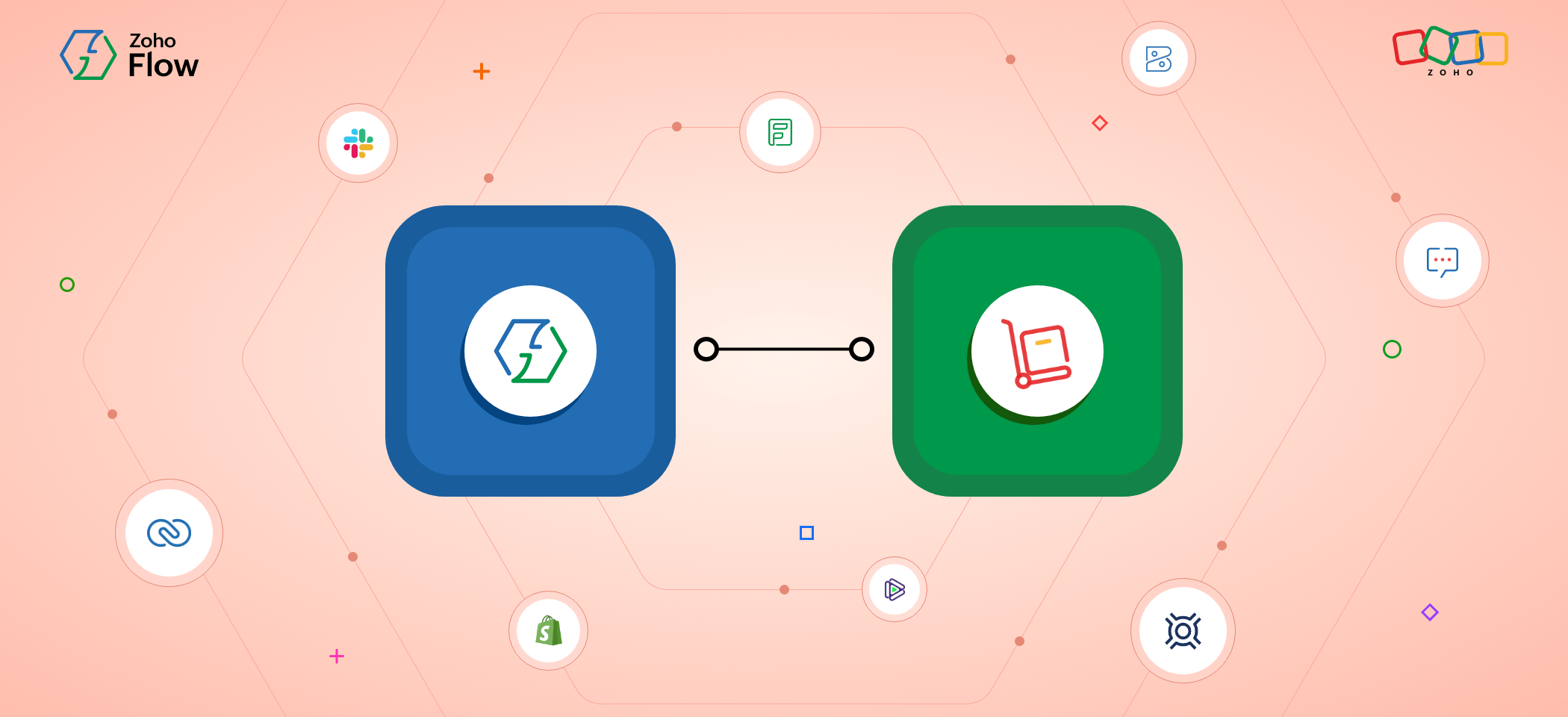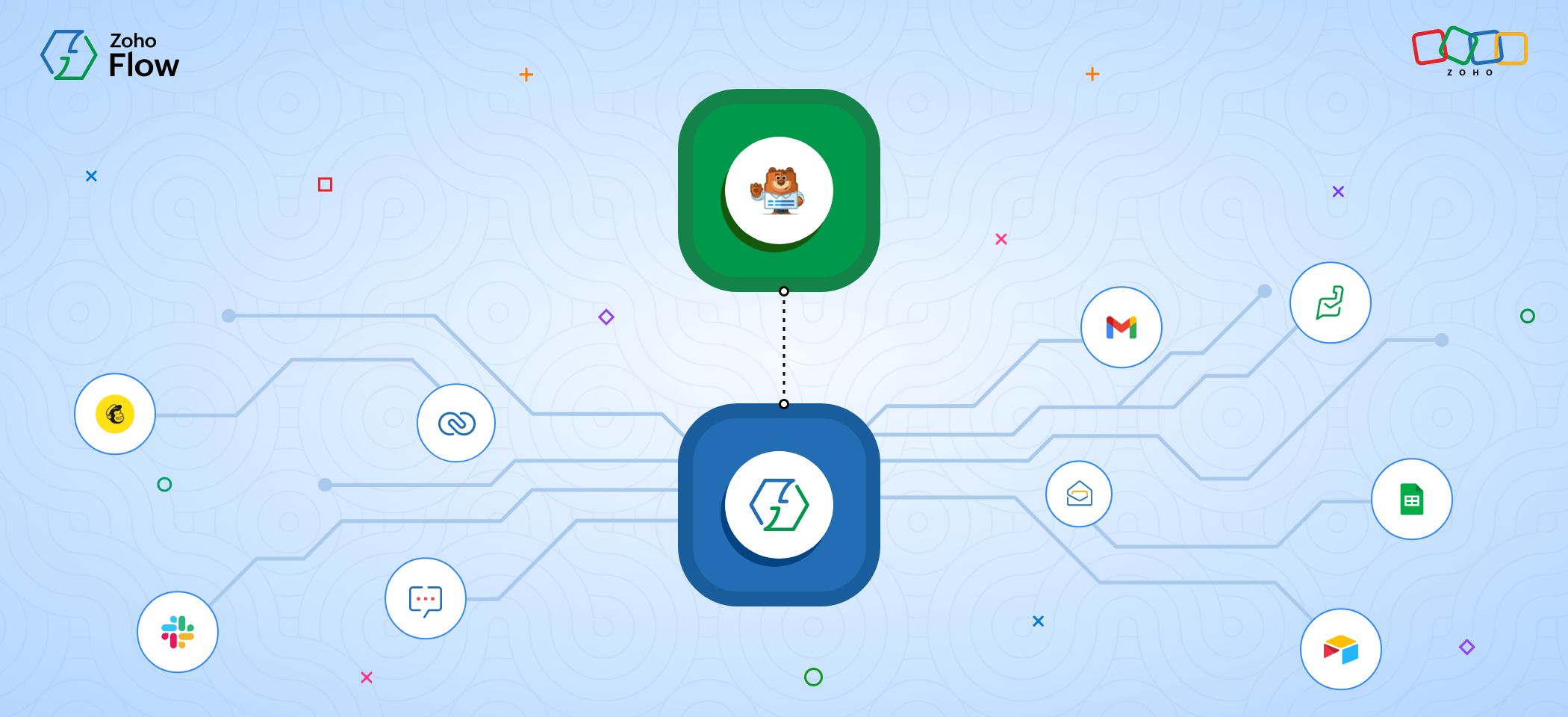6 ways to integrate Zoho Inventory with other applications using Zoho Flow
- Last Updated : March 5, 2024
- 224 Views
- 4 Min Read

Inventory management is crucial for online businesses today, as it helps you efficiently manage your stock and gives you better visibility into your inventory. However, your inventory management application is only as good as the information present in it. Without real-time data updates on your sales operations, it can be hard to consistently keep track of updated stock values.
Zoho Inventory is an inventory management application that helps you handle all your sales and presales activities, manage stock, warehouses, bills, and payments, and monitor your packaging and shipping operations. While being able to handle all this in one application is a great advantage, you can ensure that Zoho Inventory works even more seamlessly by implementing real-time data transfer in and out of the application.
By integrating your Zoho Inventory with other applications—like CRM, forms, billing, and shipping apps—using an integration platform like Zoho Flow, you'll be able to make sure that your inventory information is up to date, along with all your other relevant applications.
Now let's look at a few ways to integrate Zoho Inventory with other apps using Zoho Flow:
Update your inventory automatically when a sale is made
Every sale made must be updated in your inventory application to ensure that you always know the quantity you have left in stock. This will help you take sales orders based on your inventory quantity, making sure that there's no confusion or conflict between you and your customers.
Manually updating every sale in your inventory application manually isn't ideal, as it introduces delays and errors in your operation. Integrating your inventory applications, like Zoho Inventory, with e-commerce applications, like Shopify, means that every time a sale is made your inventory will automatically be updated, ensuring real-time data transfer and eliminating manual effort.
Update form entries in your inventory application
Forms are one of the most efficient ways to collect sales orders. Since your inventory stock value is very important for addressing sales inquiries, you'll have to ensure that all your sales order forms are also moved to your inventory application. This will not only help you keep track of your sales orders but also provide you with a better understanding of how many orders your inventory can handle.
This can be done using a simple integration that will bring form applications like Zoho Forms in contact with Zoho Inventory. By integrating these two applications, every time a sales order is filled out by a potential customer through Zoho Forms, these forms will be moved to your Zoho Inventory instantly, helping you manage your stock values better.
Transfer data seamlessly between your CRM and inventory
CRM is the nucleus of a business, as it helps you manage your sales, marketing, finance, and more—which is why you'll want to bring all your data, including your inventory data, into your CRM in real-time, to ensure that you have full visibility of your business on a single platform.
By integrating Zoho Inventory with CRM applications like Zoho CRM, you'll be able to instantly transfer all your inventory information to your CRM with every update to stock values in Zoho Inventory. This lets you manage all your inventory activities from within your CRM, which generally acts as a comprehensive platform for sales- and marketing-related operations.
Keep your books updated and generate instant invoices
Your inventory application and your accounting application should be consistently in touch with each other, as the information within these two apps is crucial for every sale you make. Your inventory app keeps track of your stock values while your accounting application manages all the finance-related requirements.
Integrating inventory apps like Zoho Inventory with finance applications like Zoho Books will ensure that every time a sale is completed and an invoice is generated through your inventory app, the transactional data will automatically be transferred to Zoho Books, keeping both your stock data and your financial information up to date.
Get notified when there's an update to your stock
When you connect all your applications, like e-commerce apps, form apps, and finance apps, to your inventory, every update regarding your stock values will consistently be up to date, in real-time, in your inventory application. This will ensure that every time you log in to Zoho Inventory, you'll see the updated stock values of your products. But what if you haven't logged in?
With the number of SaaS applications that businesses use today, it's a hassle to constantly be logging in to every application for updates. This is where receiving notifications on your mobile phone can be useful. By integrating Zoho Inventory with messaging applications like Zoho Cliq or Slack, you'll be able to get text notifications for every stock update to your inventory.
Simplify shipment tracking for your customers
With online orders, it's important to consistently display shipment tracking information to your customers. For that to happen, you need to transfer the shipment tracking information from your shipment tracking app to your inventory management system. This data will then be available for your customers to see on your e-commerce website, which should also be integrated with your inventory application.
This automated workflow can be set up by integrating shipment tracking applications like Shiprocket or OptimoRoute with your Zoho Inventory, which will consistently update the shipping information in your inventory platform. You'll then want to integrate Zoho Inventory with e-commerce applications like Shopify to ensure that the shipping data is available for customers to easily access.
These are just a few ideas you can implement to connect your inventory application with your stack of SaaS applications, to build automated workflows to enhance productivity, as well as save you time. You can build many more integrations like these using Zoho Flow, to ensure there's a seamless flow of data transfer in and out of your Zoho Inventory.
 Sooraj
SoorajContent writer for Zoho Flow. Ardent fan of sports and movies.


